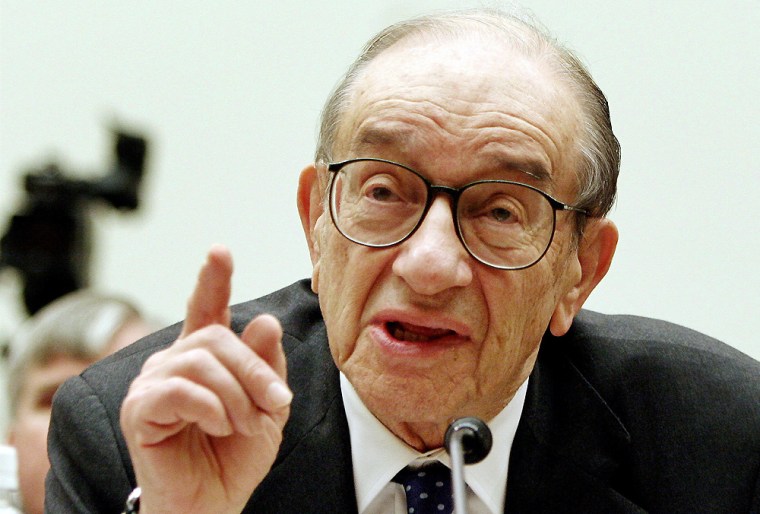Federal Reserve Chairman Alan Greenspan and his central bank colleagues are virtually certain to raise interest rates a quarter-point when they meet Tuesday. What is less certain is whether the Fed will offer Wall Street any hint that the steady 18-month rate-hike campaign is near an end.
With only six weeks and one more scheduled meeting of policy-makers left in Greenspan's 18-year tenure, some analysts believe the central bank will begin to fine-tune its language. That could offer more of a clean slate to incoming chairman-designate Ben Bernanke, who is scheduled to take over Feb. 1 pending Senate confirmation.
A change in the boilerplate language used by the Fed to explain its rate decisions also could open the door to potential "exclamation point" rate hikes that help keep a lid on inflation by surprising the market.
On the other hand, if the Fed leaves its language basically unchanged, it would signal a plan to raise rates again next month at Greenspan's final meeting Jan. 31 and possibly again in March at Bernanke's first session as Fed chair.
Since the Fed began raising short-term rates by a steady quarter-point per meeting in June 2004, the regular moves have become increasingly predictable by a Fed aiming to be as transparent as possible is it brings rates up from a 46-year low to a level considered more "neutral."
After Tuesday's expected move, the benchmark overnight rate will be at 4.25 percent, compared with 1 percent in June 2004. Other short-term rates that affect consumer and businesses have risen a comparable amount including the prime rate and some credit card rates.
A Reuters survey of Wall Street economists found just over half expect some changes in Tuesday’s statement, such as dropping or watering down a longtime description of current monetary policy as “accommodative,” given that current rates are no longer clearly boosting growth.
The other critical piece of guidance about future policy — that rate increases will continue to be “measured” — is likely to be preserved Tuesday since at least one more rate rise after December is universally expected by economists and financial markets.
David Rosenberg, chief North American economist for Merrill Lynch, argues that if the word "measured" is retained Bernanke likely will push for a rate increase in March rather than opening his tenure by moving the Fed to the sidelines.
"History shows that new Fed Chairmen like to flex their anti-inflation muscles right away," he said in a recent commentary. "Out of the sample size of five we have in the past five decades, only Arthur Burns cut rates at his first meeting. Then again, he was the architect of the inflation spiral of the 1970s, so take little consolation in that."
“There is short-term certainty and medium-term mystery for the Fed,” said Carl Tannenbaum, chief economist at LaSalle Bank, who expects the Fed to push its benchmark rate to 5 percent before stopping.
The Fed has nudged up the funds rate in an effort to keep the economy on an even keel and inflation in check. Changes to this rate influence a range of interest rates for consumers and businesses.
If the Fed acts as expected on Tuesday, the prime lending rate — for certain credit cards, home equity lines of credit and other loans — would increase to 7.25 percent, the highest in more than four years.
The changing of the economic guard at the Fed raises some uncertainties in terms of economists’ outlook for interest rates.
But there also is the challenge of accurately predicting how the economy will fare, months from now, on employment, production and inflation. That is what Fed policymakers must do when they make interest-rate decisions.
Economic barometers recently have shown positive signs:
- The economy grew at an energetic 4.3 percent in the third quarter, from July through September, despite the ill effects from the Gulf Coast hurricanes.
- Growth is expected to be solid in the current October-December period.
- Employment rebounded in November after a two-month lull, with payrolls expanding by 215,000.
- Inflation, excluding energy and food prices, appears to be fairly well-behaved.
Yet there are concerns.
Economists worry that inflation could pick up, especially given record-high natural gas prices. Others fret that a sharper-than-anticipated slowdown in the housing market could drag down overall economic activity.
Against this backdrop, Fed policy-makers at their Nov. 1 meeting suggested that their predictable rate-raising campaign could turn less predictable.
Minutes of the meeting show they discussed the possibility of altering language in the statements on interest rates that they issue after their sessions. Investors and other Fed watchers parse those statements for clues about future moves on rates.
“Several aspects of the statement language would have to be changed before long, particularly those related to the characterization and the outlook for policy,” the minutes said.
